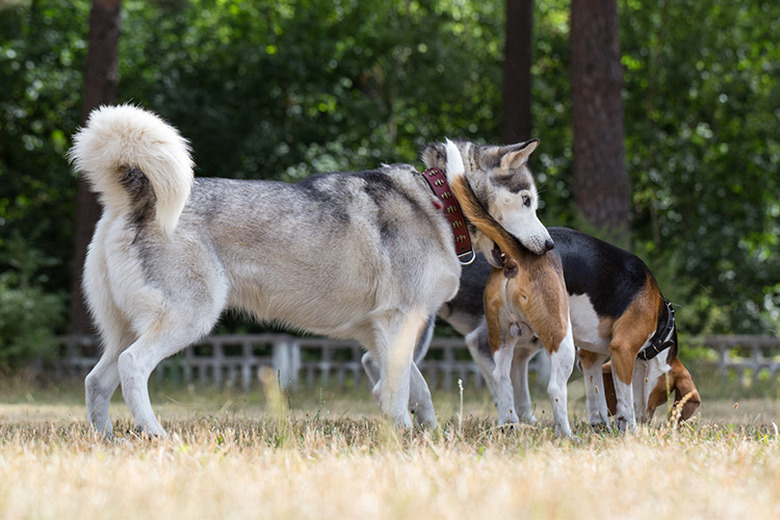My Dog Bites Other Dogs' Tails
Discourage your dog from biting other dogs, whatever part of the anatomy he chooses to go for. A wagging tail can be an intense visual stimulus for some dogs. For other dogs, it's so stimulating that they can't resist biting it. Tail-biting is typically caused by overexcitement during play, rather than aggression. It's essential to break your dog from this habit for many reasons, not least because it might earn him a severe telling off from the dog to whom the tail belongs.
Learn How To Spot The Signs
Start out by leashing your dog when other dogs are around. It's essential to have full physical control over Lucky if he's a tail biter. Let him mingle with other dogs and look out for the signs that precede a tail bite. For example, he may have a good sniff of a dog's backside before doing this. He may only bite a wagging tail or he may bite when over excited during play. Note down the signs and stimuli that precede a tail bite.
Correcting the Behavior
Step #1 - Put Lucky on a leash and let him interact with other dogs. If you have a sympathetic friend who owns a docile dog, ask if she'd be willing to help by letting her dog be the "practice dog." You'll be restraining Lucky from biting, but if possible, it's always easier to practice with a relaxed dog.
Step #2 - Praise Lucky verbally for as long as he exhibits good manners. This praise is a positive reinforcer that will encourage him to make a positive association with calm, appropriate behavior. You can take it away if he messes up.
Step #3 - Monitor his behavior. Use your understanding of his body language to predict when he is likely to go for the tail. It's essential to stop him before he has a chance to nip that tail, so pay close attention to what he's doing.
Step #4 - Correct Lucky when he goes near the other dog's tail by firmly tugging his leash and removing the praise. Say "no" in a firm voice and walk him away, then ignore him for one minute. By taking away the verbal praise, you show Lucky that when he goes near the other dog's tail, the positive stimuli he was previously enjoying is taken away. You can typically wait for a dog to make a mistake before correcting him, but when it comes to biting, it's essential to stop it before it happens. This means creating an aversion to going near other dogs' tails, not just an aversion to biting them.
Step #5 - Repeat this exercise four or five times a day, leaving a five minute time-out period between each exposure to the dogs. With sufficient repetition, Lucky will learn that putting his mouth near another dog's tail has negative consequences, while not doing so results in verbal praise.
By Simon Foden
References
Dog Behaviour: Being Too Boisterous, Play-Biting, Play-Fighting
About the Author
Simon Foden has been a freelance writer and editor since 1999. He began his writing career after graduating with a Bachelors of Arts degree in music from Salford University. He has contributed to and written for various magazines including "K9 Magazine" and "Pet Friendly Magazine." He has also written for Dogmagazine.net.
